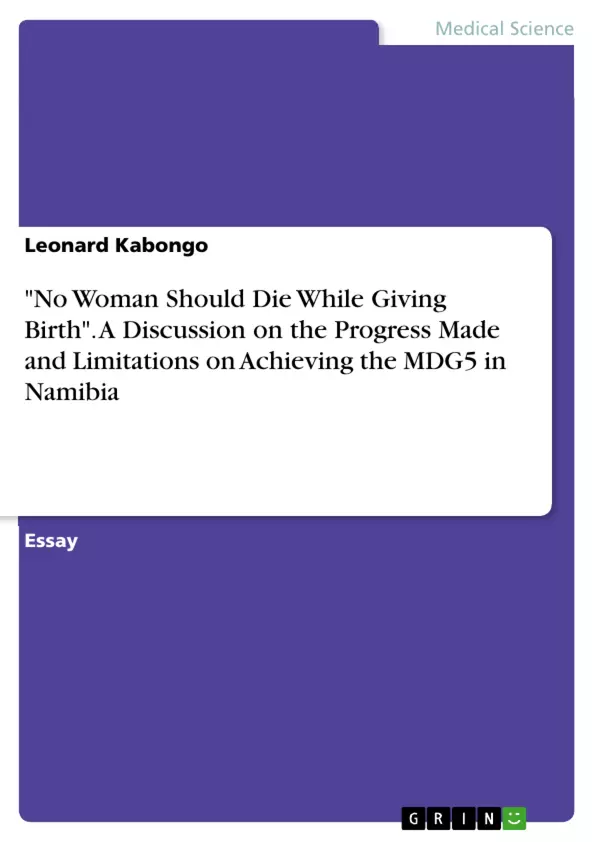The fifth Millennium Development Goal (MDG5) calls for improving maternal health and focuses on two specific objectives: the reduction of global maternal mortality ratio (MMR) by two third and the universal access to reproductive health by the year 2015 (United Nations, 2013).
Recent data shows that globally the Maternal Mortality Ratio has seen a significant decrease from 400 per 100,000 live births in 1990 to 260 per 100,000 live births in 2008 (Zere et al, 2011). Despite this world progress, some 300,000 women died in 2013 from causes related to pregnancy and childbirth whereby 62% of the deaths occurring in Sub-Saharan Africa (United Nations, 2014).
Access to a comprehensive package of reproductive health services has seen an improvement with 83% of pregnant women attended by a skilled health worker at least once during their pregnancy in 2012 compare to 65% in 1990 (United Nations, 2014).
According to the United Nations (2014), there remain extreme differences in maternal mortality among countries with almost one third of global deaths concentrated in India (17%) and Nigeria (14%); with Sierra Leone being the Country with the highest MMR (1100 per 100,000 live births) while Belarus has the lowest (1 per 100,000 live births).
Namibia is one of the affected sub-Saharan countries. It is estimated that, everyday a woman dies in Namibia due to complications related to either pregnancy or childbirth. The Maternal Mortality ratio has increased from 225 per 100,000 live births in 1992 to 271 per 100,000 live births in 2000 and 449 per 100,000 live births in 2007/2008 (WHO, 2009).
This data has put the Country on a balance scale to initiate and develop policies and programs for the acceleration of the reduction of MMR against set targets and reverse the trends to achieve 75% reduction in accordance with the MDG5 target.
The purpose of this paper is to critically analyze policies, strategies and programs that were developed in Namibia to meet the global and country targets for the attainment of the MDG5.Also to evaluate the progress made ,discuss challenges and identify way forwards for local and global response.
This essay will review the Millennium Development Goals agenda, the Namibian Country health status in the context of MDG 5 and the policies, strategies and programs developed to mitigate Maternal Mortality.
Inhaltsverzeichnis (Table of Contents)
- Introduction
- Background to the Millennium Development Goals agenda
- Background to the Namibian Health Status
- Programs and policies developed for the attainment of MDG5 in Namibia.
- Way forward....
- References
Zielsetzung und Themenschwerpunkte (Objectives and Key Themes)
This paper aims to critically analyze the policies, strategies, and programs developed in Namibia to achieve the Millennium Development Goal 5 (MDG5) regarding improving maternal health. It further evaluates the progress made, discusses challenges, and identifies ways forward for both local and global responses.
- The Millennium Development Goals agenda and its focus on maternal health.
- The health status of Namibia in the context of MDG 5.
- Policies, strategies, and programs designed to reduce maternal mortality and improve access to comprehensive sexual and reproductive health services in Namibia.
- The progress made and limitations experienced in achieving MDG5 in Namibia.
- Recommendations and future directions for addressing the ongoing challenges in achieving MDG5.
Zusammenfassung der Kapitel (Chapter Summaries)
- Introduction: This chapter introduces the fifth Millennium Development Goal (MDG5), which aims to improve maternal health and reduce global maternal mortality by two-thirds by 2015. It highlights the global progress made in reducing maternal mortality but also acknowledges that significant challenges remain, particularly in Sub-Saharan Africa.
- Background to the Millennium Development Goals agenda: This chapter provides a brief overview of the Millennium Development Goals (MDGs), emphasizing the importance of health-related MDGs (4, 5, & 6) for global sustainable development. The MDGs were adopted by 189 UN member states in 2000 and aim to address key development challenges, including poverty, education, gender equality, and health.
- Background to the Namibian Health Status: This chapter discusses the specific context of Namibia, a country in Southwest Africa with a population of 2.1 million. Despite being classified as an upper middle-income country, Namibia faces significant socioeconomic and health challenges, including high poverty rates, limited access to sanitation, and a fragmented health system. The chapter also highlights the concerning trend of increasing maternal mortality rates in Namibia.
Schlüsselwörter (Keywords)
The key themes and concepts explored in this paper include maternal mortality, Millennium Development Goal 5 (MDG5), reproductive health, comprehensive sexual and reproductive health services, health policies, strategies and programs, progress made and limitations, challenges faced, way forward, Namibia, and Sub-Saharan Africa.
- Arbeit zitieren
- Dr Leonard Kabongo (Autor:in), 2015, "No Woman Should Die While Giving Birth". A Discussion on the Progress Made and Limitations on Achieving the MDG5 in Namibia, München, GRIN Verlag, https://www.grin.com/document/305672



